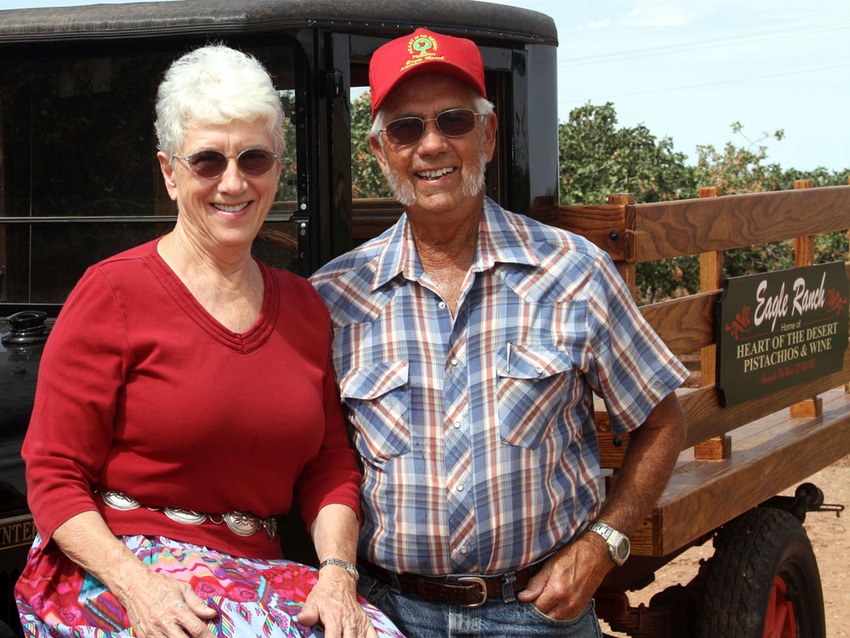June 30, 2015

The outlook for Marianne and George Schweers’ 2015 pistachio crop in Alamogordo, N.M., looks bright, thanks to good fall and winter rains plus above average chilling hours.
“We had a really great winter,” says Marianne, the farm matriarch who with her husband, George, own and operate their Eagle Ranch Pistachios farm in south central New Mexico, located about 80 miles from the U.S.-Mexico border.
The farm is located at the southern tip of the Rocky Mountains in the Tularosa basin. This area of the Chihuahuan desert between the San Andreas and Sacramento Mountains was once an inland sea.
“We had lots of chilling hours and lots of moisture,” Schweers said. “We had rain this spring, which is very unusual for our operation.”
Good chilling hours
Looking at this year’s pistachio crop prospects, she explained, “We have a good crop set. The pollination between male and female varieties was timely which we believe was due to good numbers of chilling hours.”
The Schweers farm 105 acres of pistachios and 20 acres of wine grapes in the New Mexico high desert at 4,400 feet elevation. Eagle Ranch is located in Otero County on Highways 54 and 70 between Alamogordo and Tularosa.
“We like to have 1,000 winter chilling hours under 45 degrees – or at least 850 hours,” Marianne said. “This past winter we had about 1,100 chilling hours which was really good for the trees.”
Adequate chilling hours can improve fruit set and quality.
The first pistachio trees in New Mexico were planted in 1972, and the Schweers acquired them in 1974. Tree spacing in subsequent plantings have varied, including 17X17 to 24X24. Today, the preferred spacing is 17X19 feet.
The farm has about 13,000 trees.
All female nut varieties are Kerman. Male varieties include Peters and others. Older rootstocks include Atlantica and Terebinthus. The newer plantings are on UCB-1 rootstock.
The soil is a sandy loam. While the pistachio tree in most growing areas is typically alternate bearing, the Schweers’ trees do not have much yield change from year to year.
Yield consistently averages 1,800-3,000 pounds (dry weight) per acre.
Plagued by drought
New Mexico has been plagued by drought over the last several years, like its sister states in the West. The Schweers received a meager two inches of rain last year until the fall rains began. Year-end rainfall pushed four inches.
The farm relies on groundwater for crop irrigation. Schweer calls the water quality “poor” but good enough for the higher salt-tolerant pistachio tree.
“Our water quality is affected by the snowpack in the mountains. A melting snowpack pushes fresh water against the brackish water of the ancient seabed, improving the quality of the water.
Due to the desert environment, New Mexico closed the basin to drilling new irrigation wells in the 1980s.
Schweers added, “Permits to drill wells for water over the existing allotment are difficult to impossible to obtain.”
Pest, disease issues
On the pest and disease side, squirrels and ravens love nuts and are the top two predators at Eagle Ranch. Schweers says the BirdGuard company’s sonic (sound) bird repeller is the most effective method to keep birds out of the orchard. Also a big help is Sam, a Labrador retriever.
The two chief insect threats are the stink bug and leaffooted bug. The insecticide Permethrin is applied as a spray as needed but in most years is not required.
Navel orangeworm (NOW) is the top insect threat in California - the nation’s largest pistachio-producing state, but it’s not a large concern on the Schweers’ operation due to the isolated location and the far distance from NOW host crops.
NOW is seldom found in the orchards. When it is, orchard sanitation works well.
Vertically integrated
The farm is vertically integrated with on-site processing, marketing, and sales under the trademark name Heart of the Desert.
“We are so isolated that we are a self-contained operation with production, processing, packaging and marketing all in one place. The farm has one customer – Heart of the Desert – for our pistachios and wines.”
Packaged pistachios are sold in the on-farm store and at three Eagle Ranch stores located in the Las Cruces area and Ruidoso. The flavored pistachio offerings include the palate-teasing flavors green chile, red chile and lime, garlic and green chile, garlic and onion, plus the popular salted and roasted.
Schweers says New Mexico has about 30 pistachio growers for a total state acreage of 350-400 acres. About six growers farm parcels of 40 acres or more.
On the wine grape side, the Schweers grow seven varieties, including Chardonnay, Cabernet Sauvignon, Gewürztraminer, Riesling, Syrah, Zinfandel, and Malvasia Bianca.
“Our wine grapes really do well here,” said Schweers.
Cumbersome regulations
When asked about the biggest challenge the family farm faces, Schweer pointed to cumbersome federal regulations tied to the farm’s remote location. The farm must deal directly with the Environmental Protection Agency, Food and Drug Administration, and the Occupational Safety and Health Administration.
The last required on-farm visit by a government official to draw a sample to test for aflatoxin in pistachios cost the Schweers about $570, mostly tied to travel expenses to the farm’s location.
“We understand that larger operations can absorb those costs better than we can. For us, it’s really challenging,” Schweers concluded.
You May Also Like




